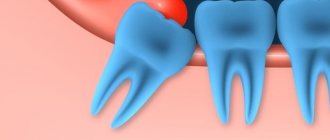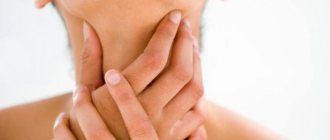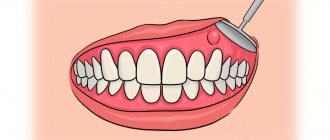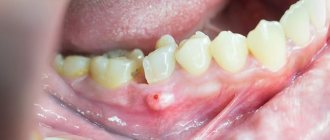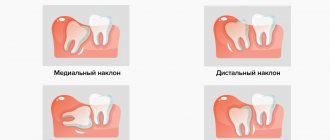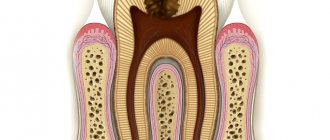One of the most common reasons for patients visiting dental clinics is traumatic damage to teeth and surrounding tissues. At any age, a tooth bruise can occur - a painful injury, which, despite the discomfort, at first looks quite harmless. Subsequently, it often turns out that the pain does not subside, and the bruised tooth begins to react to hot or cold. This usually means that the neurovascular bundle—the dental pulp—is damaged, and a visit to the dental office is necessary.
Even a very careful adult can get a severe bruise to a gum or tooth (for example, by not calculating the movement and hitting himself with a spoon or glass). What can we say about kids who are constantly on the move and often fall, hitting their teeth on various objects. As a result, enamel cracks, root fractures, dislocations and other injuries occur. In the ICD (International Classification of Diseases), chapter 29 is devoted to dental injuries, which describes the consequences of single or multiple mechanical impacts leading to disruption of the integrity of teeth and surrounding tissues.
Main reasons
Dental injuries can occur for various reasons, the most common of which are:
- accidental impact of the jaw on a hard object during a fall or in an accident;
- a blow to the front teeth with a glass, spoon or other utensil (sometimes such blows are so strong that they break off part of the incisor);
- a blow to the teeth with a fist or other blunt object (a professional injury that often occurs among fighters of various martial arts);
- chronic injuries associated with a person’s habits or lifestyle (tendency to bite nails, bite pens, frequent consumption of sunflower seeds, cracking pistachios and other relatively soft nuts with teeth);
- damage during the treatment of adjacent teeth (severe tooth bruising can occur both due to a dentist’s mistake, and due to the anatomical features of the patient, advanced diseases and other factors).
The likelihood of enamel fracture and other traumatic damage to dental tissue increases significantly with poor oral care and dental health. In this case, the enamel becomes more fragile, and the initial stages of caries may develop, significantly weakening the tooth. Timely treatment and proper oral health care significantly reduce the risk of injury to teeth as a result of a blow or other physical impacts.
The difference between a dystopic tooth and an impacted one
A dystopic tooth is a tooth that is in an incorrect (displaced) position, i.e., outside the dental arch.
This can be a tilt towards the cheek, tongue or towards neighboring teeth, tooth growth towards the palatal or labial side, as well as a rotation around its axis [8]. When they talk about an impacted tooth, they mean that it did not erupt at all and remained in the jaw or was partially erupted and then some part of the crown rises above the gum. This condition can be isolated, or it can be aggravated by dystopia, then the tooth is not only not completely in the dentition, but is also out of place [1, 2].
Symptoms of a tooth bruise
Depending on how long and intensely the tooth hurts after a bruise, one can draw conclusions about the severity of the injury.
Often, immediately after the blow, it seems that the pain gradually subsides and will soon go away completely. However, over time, the discomfort only intensifies, and when pressure is applied to the tooth itself or the gum next to it, the pain can become unbearably strong. In addition to pain, the following symptoms may be observed:
- the gums in the area of the bruised tooth swell, a hematoma or edema appears;
- the tooth may acquire a reddish tint due to blood released into the pulp from ruptured vessels;
- bruising of the front teeth can lead to noticeable loosening of individual incisors (it seems to the person that the tooth does not hold well and may fall out);
- Over time, the crown may noticeably darken due to disruption of the nutrition of dental tissues and the penetration of pollutants into enamel cracks.
Any of the listed symptoms is a serious enough reason to contact a dental clinic as soon as possible. Painful sensations always indicate the presence of damage, which can eventually lead to the loss of a healthy-looking tooth.
Symptoms of tooth dislocation
The clinical picture depends on the type of dislocation:
- If the periodontal ligament is incompletely damaged, the patient complains of pain (especially when chewing), loosening of the causative unit, and a change in its position in the row. The displacement can occur in different directions. The gums in the pathological area are swollen and hyperemic. Bleeding from the periodontal pocket is possible.
- Symptoms of avulsion: absence of a segment in a row; in place of the lost tooth there is a fresh hole filled with a clot (or bleeding). Associated signs: pain, bruises, wounds on the gums and lips.
- Signs of intrusion: the segment has become shorter compared to neighboring units (or has completely disappeared into the alveolar bed), and reacts with increased sensitivity to percussion. The pathology is often accompanied by alveolar bleeding and soft tissue injuries of varying severity.
Tooth bruise - what to do?
Please note that it is impossible to determine the severity of the injuries yourself. A complete diagnosis must include an x-ray and a professional examination in a dental office. At home, an experienced dentist can examine the damage and make certain assumptions, but even without the necessary tools, he will not be able to make an accurate diagnosis.
If it is obvious that the tooth bruise is quite serious, self-treatment is unacceptable. To ease the pain, you can apply ice or just a cold object and go to the dentist as quickly as possible. If it looks like the jaw is damaged, it is advisable to fix it with a bandage. It is advisable that someone accompany the victim, since he may lose consciousness on the road.
What to do if a tooth is dislocated
If an injury occurs, it is necessary to provide assistance to the victim and take him to a doctor for dental diagnosis and treatment.
First aid scheme:
- Examine the oral cavity. If a segment falls out, wrap it in a damp, clean cloth and put it in a bag. If there is a bleeding hole: apply a clean gauze pad to it. The victim's mouth must be closed for 30 minutes. After half an hour, the gauze can be removed. In case of a depressed injury, tamponade cannot be performed.
- Apply ice to the sore area of the cheek.
- Take the person to the dentist.
After clarifying the circumstances of the incident, the doctor will examine the oral cavity and determine the nature and type of injury. To study the details and assess the general condition of the jaw, X-ray diagnostics (orthopantomography) is prescribed. Sometimes a CT scan and EDI may be required (to monitor the pulp).
Treatment
Oral injuries can vary in nature and severity. No matter how painful a tooth bruise seems, treatment must be carried out in a specialized dental clinic. We at Natadent often encounter such cases. After the initial diagnosis, visual examination, interviewing the patient and collecting anamnesis, an x-ray is taken - this is the only way to clearly determine which tissues are damaged and prescribe the correct treatment.
By studying an x-ray, the doctor can determine what kind of damage the tooth has received (this could be a fracture, dislocation, crack, various deformations and other pathologies).
Only after a correct diagnosis can treatment be prescribed. If a tooth injury has caused serious damage, electrodiagnostics is prescribed - a special procedure that allows you to determine the condition of the pulp, detect hemorrhages and necrotic areas in it. If diagnostic actions show that the damage is not very serious, a set of preventive measures is prescribed, which includes:
- application of compresses;
- use of decoctions for mouth rinsing;
- exclusion from the diet of hot dishes and foods that require chewing; exclusion of this area of the dentition from the chewing process by applying a bandage or protective splint.
- taking anti-inflammatory drugs.
If a more serious tooth injury is diagnosed, treatment may include surgery to the structure of the tooth and surrounding tissue. The sequence of actions is determined by the complexity of the injury, but in most cases includes the following steps:
- ;
- Local anesthesia is performed (or general if complex and painful treatment is involved).
- If the pulp sac is damaged, even if the tooth enamel has retained its structure, the doctor drills a hole in it and removes the nerve.
- The canals and cavity are cleaned, treated and filled, as in conventional caries treatment.
;
;
A tooth bruise is a dangerous injury that can lead to undesirable consequences and complications. Even if pulp removal and filling have been performed, it is advisable that the patient undergo a course of therapeutic treatment, and after some time come for additional examination. Only after this can it be said that the consequences of the injury have been completely eliminated and there will be no complications.
Tooth fracture
The diagnosis is made by the dentist based on the presence of trauma in the medical history, characteristic clinical manifestations and complaints of the patient. Before choosing a treatment method, an odontometric and x-ray examination is carried out. Treatment tactics and prognosis depend on the degree of damage to tooth enamel tissue. So, if, when a fragment of the crown is broken, the opening of the tooth cavity does not occur, then the tooth is restored: the crown must be restored using composite filling materials.
Longitudinal, comminuted and oblique fractures of the tooth root require tooth extraction, since the root in this case cannot be used as a support for the pin. After tooth extraction, it is necessary to decide on prosthetics. Modern dentistry offers an alternative way to replace the dentition defect resulting from a tooth fracture - dental implantation.
A transverse fracture of the tooth root allows the tooth to be restored using an artificial metal-ceramic crown.
Also, treatment tactics depend on the level of the tooth fracture; if the fracture occurs in the upper part, then the canal is sealed, and the apical part of the tooth is left without intervention. In case of a fracture in the middle part, trephination of the tooth with removal of the pulp is indicated, then the canal is filled, and the tooth fragments are connected using pins.
When a tooth is fractured, which is accompanied by opening of its cavity and damage to the pulp, the damaged pulp must be removed and the root canal filled. If necessary, intracanal pins and filling of the crown of the tooth are used.
Fractures of any complexity with preservation of the tooth root allow the installation of an intracanal pin after cleaning and filling the canal, which allows, without resorting to dentures, to restore the integrity and functionality of the dentition.
Root canal filling is only part of the treatment, after which it is necessary to completely restore the anatomical position of the teeth. This allows you to avoid the formation of an incorrect bite and eliminate injuries during the closure of the teeth.
Treatment of dental fractures must be carried out as quickly as possible, since in the absence of contact with the antagonist tooth, tilting and displacement of adjacent teeth occurs. This may require additional orthodontic treatment before prosthetic treatment.
Possible complications
Since bruising of a gum, tooth or other tissues in the oral cavity is always individual, it is impossible to give reliable predictions about recovery and possible complications. It usually takes several visits to the dentist to carry out the necessary examinations and procedures, after which a complete recovery can be established. If you do not approach the treatment process responsibly, you can get the following complications:
- darkening of the enamel (due to the penetration of pollutants through cracks, blood entering the pulp and disruption of the nutrition of dental tissues);
- death of pulp cells and formation of necrotic areas leading to tooth death;
- chronic inflammatory processes (pulpitis and periodontitis) leading to more serious consequences.
Very often, a tooth bruise leads to serious but hidden injuries. The victim may feel minor pain and think that everything will go away soon. However, this is not a reason to avoid qualified medical care. The sooner an examination is carried out in a dental office, the greater the likelihood that all consequences will be eliminated, complications will be avoided and the tooth will be as healthy as possible.
What is tooth luxation
A small piece of connective tissue called the periodontal ligament helps hold the segment in the alveolar ridge. It is a cluster of collagen fibers penetrated by capillaries and nerves. The ligament is very thin. On the inside, the tissue is attached to the cement of the tooth root. From the outside - to the bone surrounding the unit.
During dental trauma, damage to the ligamentous apparatus and neurovascular bundle occurs. Due to the forced action, the fibers cannot support the segment, which leads to its deviation.
Diagnostics
An experienced doctor can detect a tooth dislocation with a simple examination. At the same time, he pays attention to the location of the dental crown and the characteristics of the damaged gum. However, there are cases when damage and deformation of the teeth may not be noticeable externally and, until subsequent symptoms appear, the dislocation may go unnoticed. This, in turn, will complicate further treatment.
To avoid such situations, it is important to additionally take x-rays of the teeth and jaw during the examination. It will not only confirm or refute the presence of a dislocation, but will also identify possible damage to the jaw or internal tooth tissues. This approach will allow you to choose the most effective treatment and make it possible to save the tooth itself.
Treatment of dislocation
The method of recovery depends on the type of injury. Incomplete dislocation is corrected therapeutically:
- Reposition is done (returning the unit to the correct position).
- A splint is applied to prevent crown mobility for 2-4 weeks, less often 6. The duration directly depends on the severity of the case and the individual characteristics of the body.
- Antibiotics may be prescribed.
- When possible, the dentist will begin root canal treatment.
Doctors will try to preserve the pulp, but often damaged tissue must be removed. A rupture of the neurovascular bundle means that depulpation is necessary; the canals are filled with modern compounds. Dislocations and fractures of teeth are painful. To reduce the syndrome, analgesic drugs are prescribed.
Current technologies in some cases allow tooth reimplantation. This outcome is possible if all periodontal tissues are preserved. This option is typical for a dislocated front tooth. An almost separated unit can be restored - trephination is performed, the neurovascular filling is removed, and a filling is installed. Dry statistics: a tooth root reimplanted within half an hour after injury is preserved in half of all requests.
An impacted tooth dislocation requires special treatment. These are the options:
- Constant observation and spontaneous return of the unit to its original position.
- An operation to remove the bone fragment and put it in place.
- Tooth extraction followed by implantation or other prosthetics.
The feasibility of preserving the unit is determined by the dentist, based on the general condition of the bone mass of the root zone. If the tissue is preserved throughout 50% of the root system, then the prognosis is favorable.
Prevention of tooth dislocation
Preventive measures are limited to strengthening dental injuries and eliminating risk factors. It is worth consulting a doctor, taking recommended dietary supplements, making up for the lack of calcium and vitamin D.
It is unacceptable to engage in strength sports, martial arts without a mouth guard, or to deliberately use teeth as a substitute for tools. It is not recommended to crack nuts and fruit seeds.
Since no one is insured against accidental falls, blows and dislocation of a tooth in the lower jaw or dislocation of a tooth in the upper jaw, it is reasonable to contact the clinic in the first minutes after annoying troubles.
It is impossible to determine the severity of damage on your own. Experienced doctors at the clinic will examine the symptoms of a dislocation, make a diagnosis and prescribe the correct treatment.
Consequences of dislocation
The dislocation of a tooth itself is very unpleasant, as it leads to the appearance of pain. However, its consequences can be much more dangerous. In some cases, when a dislocation occurs, not only the tooth tissue is damaged, but also cracks appear in the jaw. If they were not diagnosed on time, this may lead to subsequent inflammatory processes.
Since complete luxation causes significant damage to the gum tissue, all gaps must be repaired. If this is not done, you can get a severe infection. The same applies to the tissues of the inner surface of the cheek, which may be damaged due to improper placement of teeth after dislocation.
The cause of dislocation can also be the unprofessional actions of a dental surgeon during certain manipulations with teeth. For example, when removing a diseased tooth, the doctor can hook (press, move or partially pull out) and provoke dislocation of an adjacent tooth, which is absolutely healthy.
Important! If we are talking about the dislocation of a baby tooth in children, you should be especially careful about its consequences. It must be remembered that any deformation can lead to destruction of the dental bottom. This can cause damage to the molar or negatively affect its growth.

